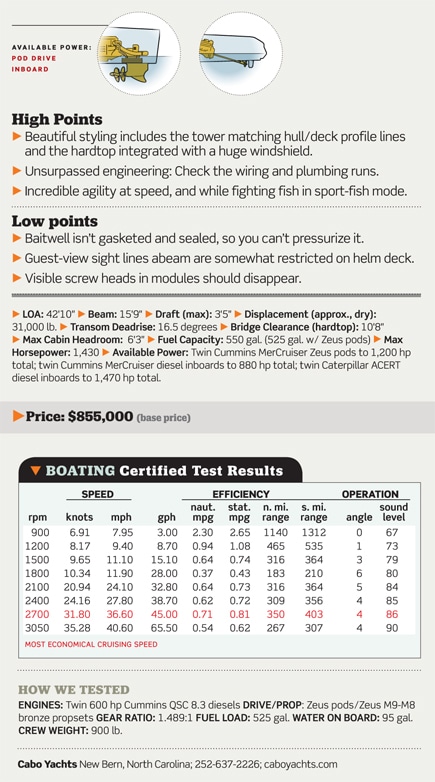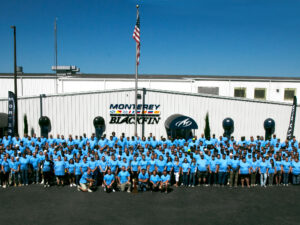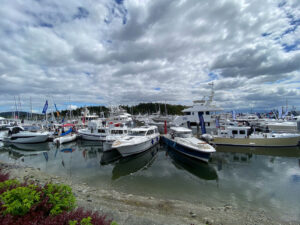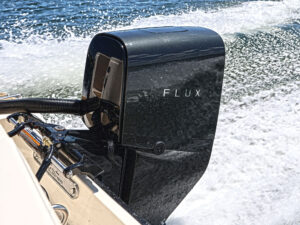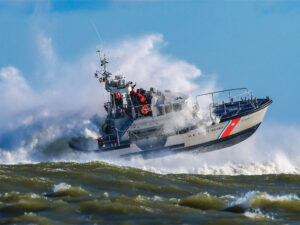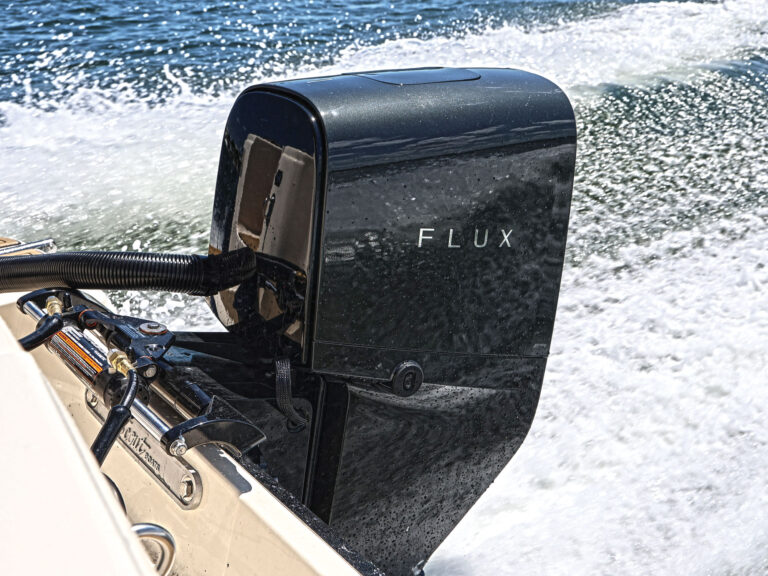Cabo Yachts enjoys a reputation for great engineering, creative designs and a demonstrated ability to raise fish. That legacy continues with the new “hardtop express” model, the 40 HTX.
Let’s start in the cockpit. Hawse pipes in the transom corners afford unfettered tie-ups. I spied an interesting footrest in the portside cockpit module that folds away when not in use. The portside module houses refrigerator/freezers and sports cushions designed so you don’t need to remove and resnap them to get into the boxes. Also, it’s nice that the hatch on the box is split (as are the cushions) so that crew seated on the mezzanine need not stand if someone wants access. The refrigerated boxes have Dometic’s Cruisair chill coils molded right into the fiberglass, making cleaning easy.
Opposite, I found a rigging station and removable tackle boxes in the starboard module.You could install optional cockpit controls or an electric grill there instead. Fuel valves, raw-water filters and pumps hide under the centerline lazarette hatch. Fish boxes port and starboard can be plumbed for a cold plate. Need to rush forward? I discovered wide side decks and excellent handholds all the way to the bow.
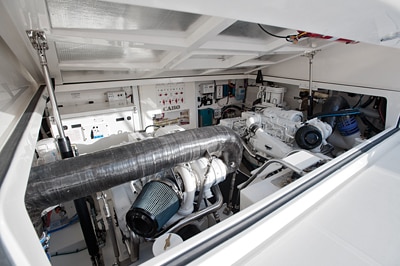
The bridge deck rises on hydraulic rams, exposing an engine compartment with such great access I could lie down between the engines, though finding the lift button proved slightly awkward. Interestingly, the 40 HTX’s target competitor, Viking’s 42 Open, offers a portable remote to raise and lower the deck — a feature with both pros and cons. The Viking’s base price with 440 hp Cummins MerCruiser Zeus pods is approximately $947,000. I admired Cabo’s beautiful wiring and plumbing harnesses and a day hatch that provides alternate access.
Bridge-deck seating consists of an L-shape settee to port housing considerable rod storage and Stidd helm and companion chairs. Opposite, a module houses more tackle storage and an insulated drink box. I enjoyed superb visibility from the helm.
My test boat’s PipeWelders tower (approximately $70,000) looked integral, beautifully melding with the 40 HTX’s lines. Cabo mounted a huge console in the tower station — bigger than the one on the Cabo 44. Sight lines provide a great view of both the cockpit and foredeck.
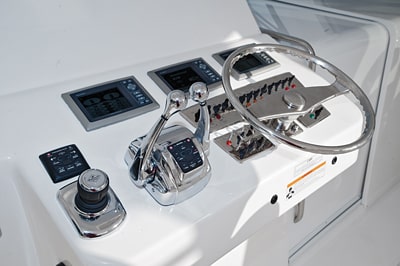
My test boat was powered by Cummins MerCruiser Zeus pods with joystick control. This diesel propulsion system features Autotab, trim tabs built into the pods. These automatically deploy when you boost the throttle to limit bow rise. Upon attaining plane, the tabs auto-adjust according to the speed. You can override them if you wish to lift the windward side in a beam sea, or simply to compensate for load.
Waiting for a bridge to open or want to fish a specific piece of bottom structure? Press the “Skyhook” button and the pods automatically keep you within a few feet of your position and on the exact heading you were on.
Powering into the Atlantic, closely spaced two- to three-foot seas proved a nonevent for the 40 HTX. Drifting in a beam sea, the Cabo exhibited a remarkably short roll moment with very gentle transitions.
It turns on a dime, thanks to standard Zeus electronic steering that adjusts for boat speed to keep everyone safe. Based on my sea trial and discussions with Cabo’s factory captain, the 40 HTX’s best cruising speed, with respect to economy and engine load, is 2,710 rpm, making 32 knots and burning 45.4 gph for a net of 0.71 nm per gallon.
Heading belowdecks, I found a handsome rod locker to showcase fishing weapons. To starboard an L-shape settee pulls out, forming a twin berth, while its back hooks to the overhead as a pullman berth. Or, replace the settee with an enclosed second cabin with over/under singles. The primary sleeping quarters in the fo’c’sle consist of an island double with tray stowage beneath the mattress. The head boasts lots of room and a stall shower. The small galley comes equipped with a microwave, single-burner cooktop, stainless sink and refrigerator/freezer drawers under the counter. The entire cabin is lined with beautiful book-matched teak veneer.
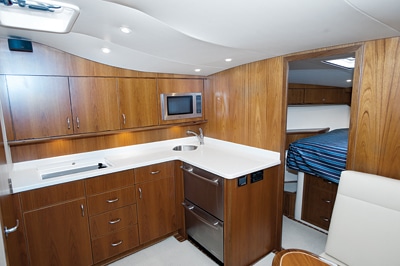
The 40 HTX’s impressive construction consists of a solid bottom, cored topsides and vacuum-bagged decks. The biaxial fabric is set in vinylester resin.
While every inch the hard-core fishing machine, the 40 HTX exudes a sense of cruising comfort at the same time. Integrating the hardtop with the windshield — eliminating the curtains between the two — makes this boat look radically better. Looks aside, however, rest assured that if it’s a Cabo yacht, it still raises fish.
Comparable model: Viking 42 Open
